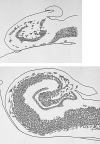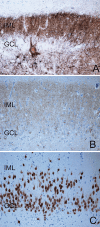Hippocampal sclerosis: progress since Sommer
- PMID: 18761661
- PMCID: PMC8094764
- DOI: 10.1111/j.1750-3639.2008.00201.x
Hippocampal sclerosis: progress since Sommer
Abstract
Hippocampal sclerosis (HS) continues to be the most common pathology identified in patients with refractory temporal lobe epilepsy undergoing surgery. Wilhelm Sommer described this characteristic pattern of neuronal loss over 120 years ago through his post-mortem studies on patients with epilepsy. Neuropathological post-mortem studies in the 20th century proceeded to contribute significantly to the understanding of this disease process, with regard to the varying patterns of HS and involvement of adjacent limbic structures. From studies of surgical temporal lobe specimens from the 1950s onwards it was recognized that an early cerebral injury could act as the precipitant for the sclerosis and epilepsy. Modern neuropathological studies have focused on aspects of neuronal injury, loss of specific neuronal groups and cellular reorganization to address mechanisms of epileptogenesis and the enigma of how specific hippocampal neuronal vulnerabilities and glial proliferation are both the effect and the cause of seizures.
Figures




Similar articles
-
Review: Hippocampal sclerosis in epilepsy: a neuropathology review.Neuropathol Appl Neurobiol. 2014 Aug;40(5):520-43. doi: 10.1111/nan.12150. Neuropathol Appl Neurobiol. 2014. PMID: 24762203 Free PMC article. Review.
-
Granule cell dispersion is associated with hippocampal neuronal cell loss, initial precipitating injury, and other clinical features in mesial temporal lobe epilepsy and hippocampal sclerosis.Seizure. 2021 Aug;90:60-66. doi: 10.1016/j.seizure.2021.05.024. Epub 2021 May 31. Seizure. 2021. PMID: 34162493
-
Hippocampal neuron damage in human epilepsy: Meyer's hypothesis revisited.Prog Brain Res. 2002;135:237-51. doi: 10.1016/s0079-6123(02)35023-4. Prog Brain Res. 2002. PMID: 12143344
-
Hippocampal MRI volumetrics and temporal lobe substrates in medial temporal lobe epilepsy.Magn Reson Imaging. 1995;13(8):1065-71. doi: 10.1016/0730-725x(95)02014-k. Magn Reson Imaging. 1995. PMID: 8750318
-
Hippocampal sclerosis--origins and imaging.Epilepsia. 2012 Sep;53 Suppl 4:19-33. doi: 10.1111/j.1528-1167.2012.03610.x. Epilepsia. 2012. PMID: 22946718 Review.
Cited by
-
Glial adenosine kinase--a neuropathological marker of the epileptic brain.Neurochem Int. 2013 Dec;63(7):688-95. doi: 10.1016/j.neuint.2013.01.028. Epub 2013 Feb 4. Neurochem Int. 2013. PMID: 23385089 Free PMC article. Review.
-
Hippocampal sclerosis in temporal lobe epilepsy: findings at 7 T¹.Radiology. 2011 Oct;261(1):199-209. doi: 10.1148/radiol.11101651. Epub 2011 Jul 11. Radiology. 2011. PMID: 21746814 Free PMC article.
-
"New Old Pathologies": AD, PART, and Cerebral Age-Related TDP-43 With Sclerosis (CARTS).J Neuropathol Exp Neurol. 2016 Jun;75(6):482-98. doi: 10.1093/jnen/nlw033. Epub 2016 May 21. J Neuropathol Exp Neurol. 2016. PMID: 27209644 Free PMC article. Review.
-
Modeling genetic epileptic encephalopathies using brain organoids.EMBO Mol Med. 2021 Aug 9;13(8):e13610. doi: 10.15252/emmm.202013610. Epub 2021 Jul 15. EMBO Mol Med. 2021. PMID: 34268881 Free PMC article.
-
Review: Hippocampal sclerosis in epilepsy: a neuropathology review.Neuropathol Appl Neurobiol. 2014 Aug;40(5):520-43. doi: 10.1111/nan.12150. Neuropathol Appl Neurobiol. 2014. PMID: 24762203 Free PMC article. Review.
References
-
- Aronica E, Gorter JA (2007) Gene expression profile in temporal lobe epilepsy. Neuroscientist 13:100–108. - PubMed
-
- Aronica E, Gorter JA, Ramkema M, Redeker S, Ozbas‐Gerceker F, Van Vliet EA et al (2004) Expression and cellular distribution of multidrug resistance‐related proteins in the hippocampus of patients with mesial temporal lobe epilepsy. Epilepsia 45:441–451. - PubMed
-
- Aronica E, Boer K, Van Vliet EA, Redeker S, Baayen JC, Spliet WG et al (2007) Complement activation in experimental and human temporal lobe epilepsy. Neurobiol Dis 26:497–511. - PubMed
-
- Babb TL, Brown WJ, Pretorius J, Davenport C, Lieb JP, Crandall PH (1984) Temporal lobe volumetric cell densities in temporal lobe epilepsy. Epilepsia 25:729–740. - PubMed
Publication types
MeSH terms
Personal name as subject
- Actions
LinkOut - more resources
Full Text Sources
Other Literature Sources
Miscellaneous

